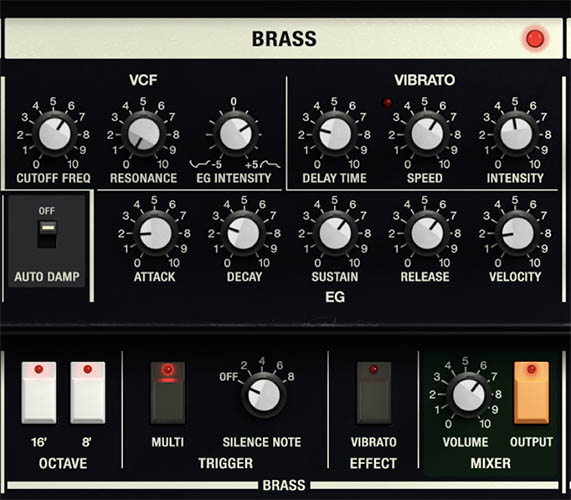Brass Section
If the Synthesizer section is Trident’s lead guitarist, the Brass section is the backing band that shows up on time and provides support. This section was designed to serve up the punch of a brass ensemble, but it’s still a synth, so don’t expect it to behave too politely. With a few knob twists, it can go from fanfares to fat stabs that cut through a mix.
Octave
Choose your register:
16’ – The classic brass range (deep, powerful).
8’ – One octave higher (brighter, cutting).
And yes, you can turn them both on for a two-octave wall of brass.
VCF (Voltage Controlled Filter)
At the heart of the Brass section is a simple but effective filter.
Cutoff Frequency – The “brightness” dial. Higher cutoff equals more sizzle and edge, lower equals mellow and muted.
Resonance – Adds emphasis around the cutoff frequency. Crank this up to increase the funk factor.
EG Intensity – How much the filter responds to the envelope (see below). Small tweaks here equal big changes in brass realism.
Envelope Generator (EG)
Unlike the synth section, the Brass envelope pulls double duty. It controls both the filter and the amplifier. In other words, this single ADSR shapes both tone and volume.
Attack – How quickly the brass “speaks.” A fast attack is good for sharp trumpet stabs, while a slower attack is like a horn player easing in.
Decay – How quickly the sound drops after the initial burst.
Sustain – The level the sound hangs at while you hold a key.
Release – How slowly (or abruptly) the note fades after you let go.
Velocity – Makes your playing touch affect how the brass responds. Hit the keys harder and you’ll get a sharper bite.
Vibrato
Because what’s brass without a little vibrato? This section adds life and realism.
Delay Time – How long before the vibrato kicks in.
Speed – The pitch modulation rate.
Intensity – The depth of pitch modulation.
Tip: Want something close to a human brass section? Dial in a small delay and moderate intensity, just like a trumpet player who settles into pitch after the first blast.
Effect Switch
A simple on/off for the vibrato effect. It's like a mute button for the trumpet player’s vibrato.
Trigger Modes
There are three ways to trigger the envelope:
Normal (no switch engaged) – Only the first note you play triggers the EG. Hold it down and play more notes, and they’ll sneak without retriggering.
Multi – Every note you play retriggers the EG. Great for punchy stabs and ensemble-style parts.
Silence Note – No brass sound at all unless you play a minimum number of keys at once. For example, set it to 4, and only four-note chords will wake up the brass. (Good for making sure your “power brass” moments only happen when you really mean it.)
Mixer
Finally, the Brass section has its own Volume knob and On/Off switch, letting you blend it against the Synthesizer and Strings sections or drop it out entirely.
Volume = Sets the overall volume of the Synthesizer Section.
On/Off = Enables and disables audio output of the Synthesizer section
So yes, the Brass section can impersonate a horn section (or at least a very synthy equivalent). But under the right circumstances (and with some clever sound design), it also moonlights as a growling, filter-driven synth beast. Treat it like a real horn player (give it space to breathe and don’t overwork it) and it’ll reward you with golden blasts of sound that will enhance the other sections of this monster synth.
Tips
Want classic ‘80s-style brass stabs? Use 16’ + 8’, fast Attack and Decay, high Sustain, and just enough filter bite (Resonance + EG Intensity) to give it presence.
Feeling bold? Crank the Resonance and EG Intensity. You’ll discover the Brass Section can do double duty as a synth lead.
